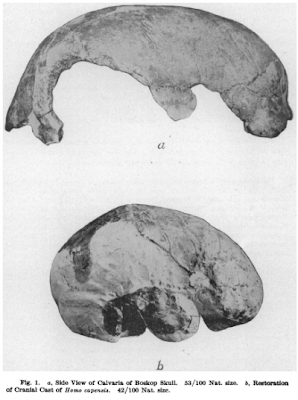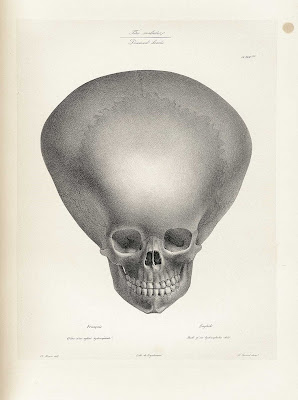Extinct Human Species Smarter Than Us?
 Over a hundred centuries ago in a dusty corner of Mother Africa, human evolution may have leaped instead of crawled. Do the remains of Boskop Man foreshadow the future of humanity? And if so, why aren't these ultimate humans here now, instead of us?
Over a hundred centuries ago in a dusty corner of Mother Africa, human evolution may have leaped instead of crawled. Do the remains of Boskop Man foreshadow the future of humanity? And if so, why aren't these ultimate humans here now, instead of us? The path of human evolution has been anything but a straight line from past to present. Much like a growing tree or a flowing river, branches and tributaries appear off the main trunk and either thrive, or taper off and peter out. When the game is survival of the species, evolutionary adaptations are mercilessly judged by nature, red in tooth and claw.
The path of human evolution has been anything but a straight line from past to present. Much like a growing tree or a flowing river, branches and tributaries appear off the main trunk and either thrive, or taper off and peter out. When the game is survival of the species, evolutionary adaptations are mercilessly judged by nature, red in tooth and claw.Evolution is also punctual in character. Change is often sudden, provoked by a beneficial mutation or a rapid change in the environment. When we look at the human family tree, all of the aforementioned trends can be seen. Neanderthal Man appears, thrives for a time in the glaciated terrain of prehistoric Europe, then fades out just as modern man appears on the scene. Further back in time, a plant-eating hominid called Australopithecus Boisei branched out from the main Australopithecine line. Robust in frame with huge teeth and mighty jaws, A. Boisei was perfectly adapted for lush, tropical conditions with abundant flora... until the climate changed and the flora died off. The gentle giants did likewise.
Specialized adaptations like the Neanderthal's ruggedness and A.Boisei's plant-eating were exceptions to the general trend of human evolution - that being an increase in brain size and a corresponding reduction in jaw size. This trend is coded in our genes, but is still subject to the influences of environment and mutation. This brings us to a group of skulls and skeletal remains found in the early years of the 20th century, in a part of South Africa known as Boskop. Could it be that in this isolated African backwater, a genetic mutation appeared that jumped human evolution ahead... not just by a page or two, but by several chapters?




One might think that a brainier, presumably smarter human population would make mincemeat out the local carnivores while out-competing any "normal" Homo Sapiens who ventured into their territory. Not necessarily. A sudden shift towards a futuristic physiognomy - without the accompanying societal, mechanical and technological framework needed to support it - would have left the Boskopoids much like babes in the woods. Balancing oversized heads on slim, gracile bodies, they would be at a pronounced disadvantage when running down prey - or running away from predators.
 A scientific analysis of the Boskop fossils, "Big Brain: The Origins and Future of Human Intelligence," was recently published by Gary Lynch and Richard Granger, neuroscientists from the Dartmouth Brain Engineering Laboratory. A more poetic reflection on Boskop Man entitled "Man of the Future" was written in 1958 by science writer Loren Eiseley as a chapter of his larger volume, "The Immense Journey". It makes for intriguing reading, as the following excerpt indicates:
A scientific analysis of the Boskop fossils, "Big Brain: The Origins and Future of Human Intelligence," was recently published by Gary Lynch and Richard Granger, neuroscientists from the Dartmouth Brain Engineering Laboratory. A more poetic reflection on Boskop Man entitled "Man of the Future" was written in 1958 by science writer Loren Eiseley as a chapter of his larger volume, "The Immense Journey". It makes for intriguing reading, as the following excerpt indicates:"The man of the future came, and looked out among us once with wistful, if unsophisticated eyes. He left his bones in the rubble of an alien land. If we read evolution aright, he may come again in another million years."
Was Boskop Man, a man out of time... stranded in a rough, predatory world without the tools needed to master it. Or is there another possibility, one which demands you open your mind to things that fly in the face of what we've so far taken for granted.
What if the Boskopoids not only survived, but thrived? What if they used their advanced intelligence to "leave the cradle", as it were. Where would they go? Well, the universe is a big place. If they left Earth for bigger and better things, one might assume they would leave as little trace of themselves as possible out of respect for their more primitive yet upcoming cousins - us.
 All right, if you've taken this leap of faith, consider what it means and where it leads. Boskop Man suddenly appeared, used his big brain and superior intelligence to create a technology so advanced that it allowed them to leave the Earth entirely, but... would they forget the place of their birth so easily? Consider what a Boskopoid would look like: huge, rounded heads, big wide eyes set into small, child-like faces - sound familiar? To paraphrase FDR, "we have met the aliens, and they are us!"
All right, if you've taken this leap of faith, consider what it means and where it leads. Boskop Man suddenly appeared, used his big brain and superior intelligence to create a technology so advanced that it allowed them to leave the Earth entirely, but... would they forget the place of their birth so easily? Consider what a Boskopoid would look like: huge, rounded heads, big wide eyes set into small, child-like faces - sound familiar? To paraphrase FDR, "we have met the aliens, and they are us!"I will admit, the curious combination of facts and speculation in this article read like something out of a sci-fi fantasy. It's much more likely that the remains of Boskop Man represent only a few members of prehistoric modern Homo Sapiens whose cranial capacities are at the far upward limits of the average. However - stranger things have happened and the current level of our archeological knowledge is by no means the be all and end all. The recent discovery of tiny "hobbit" humans on the Indonesian island of Flores is a perfect example. So keep an open mind, and remember... nothing is impossible, only improbable.
Article by Steve Levenstein from Inventor Spot. Submit your thoughts - click here!

 This type of marriage is, not surprisingly, very rarely found around the Globe. It occurs among populations where there are fewer women than men. Female tendencies to find husbands out of a sack first appeared among traditional matriarchal societies. In such primitive groups there was a tradition to kill baby girls in order to reduce the occurrence of births. As a result the female population gradually decreased in comparison to the male population -- and thus the term, "It's a Man's World"?
This type of marriage is, not surprisingly, very rarely found around the Globe. It occurs among populations where there are fewer women than men. Female tendencies to find husbands out of a sack first appeared among traditional matriarchal societies. In such primitive groups there was a tradition to kill baby girls in order to reduce the occurrence of births. As a result the female population gradually decreased in comparison to the male population -- and thus the term, "It's a Man's World"? Polygamy, on the other hand, is when a woman or man is married to more than one spouse. Polygamy is a term which is most often used when describing how a man is married to more than one woman. This description is incorrect because the concept of polygamy means a situation where either a man or woman is married to more than one spouse. The situation where the man or woman is married to more than one spouse can be sorted into different sociological categories and concepts. These include how a man can be married to more than one woman (polygyny) and how a woman can be married to more than one man (polyandry).
Polygamy, on the other hand, is when a woman or man is married to more than one spouse. Polygamy is a term which is most often used when describing how a man is married to more than one woman. This description is incorrect because the concept of polygamy means a situation where either a man or woman is married to more than one spouse. The situation where the man or woman is married to more than one spouse can be sorted into different sociological categories and concepts. These include how a man can be married to more than one woman (polygyny) and how a woman can be married to more than one man (polyandry).  Although historically many societies witness single husband marriages, many women have married more than one man due to the geographical conditions and economic problems. For example; When there was limited land for usage in Tibet, a group of brothers all married the same woman. By marrying the same woman they were able to produce fewer children and avoid a split in their future inheritance. Consequently they were able to establish financial security to a certain degree.
Although historically many societies witness single husband marriages, many women have married more than one man due to the geographical conditions and economic problems. For example; When there was limited land for usage in Tibet, a group of brothers all married the same woman. By marrying the same woman they were able to produce fewer children and avoid a split in their future inheritance. Consequently they were able to establish financial security to a certain degree. With a life increasingly built upon seeking the approval and status of the upper class, we seem to have forgotten the fundamental meaning of existence. Be it negligence, self-indulgence, excessive spending or ambivalence, we are all faulty for losing touch of reality and for failing to answer the cries of our future generation. Over 2 million children are forced in child prostitution every year. Despite this shocking amount there has been no real counter-effective action from governments and the numbers still show a cumulative curve.
With a life increasingly built upon seeking the approval and status of the upper class, we seem to have forgotten the fundamental meaning of existence. Be it negligence, self-indulgence, excessive spending or ambivalence, we are all faulty for losing touch of reality and for failing to answer the cries of our future generation. Over 2 million children are forced in child prostitution every year. Despite this shocking amount there has been no real counter-effective action from governments and the numbers still show a cumulative curve. Aneta was 17 when her ordeal began. She was promised a job as an au pair to an affluent family when she decided to leave her Czech village and cross borders. She was recruited by Petr, a handsome man who promised that she would travel with them to London or even America. "You'll get to practice your English," he joked. The next day Aneta joined ten other local girls who handed over their passports and followed Petr into a life of ruins and defilement. Hours later instead of being welcomed by smiling families, they were greeted by a group of burly men who possessed guns and savage dogs. The girls, some of them as young as 14, were then forced into a room, stripped naked and pushed into a line. The men moved up and down, along the line and handled the girls roughly. They inspected their teeth, breasts and the areas between their legs. “We were just horseflesh” Aneta recalled. Each girl was flung across the room and gang raped. Within the next few days all of them were smuggled across Europe to work in brothels.
Aneta was 17 when her ordeal began. She was promised a job as an au pair to an affluent family when she decided to leave her Czech village and cross borders. She was recruited by Petr, a handsome man who promised that she would travel with them to London or even America. "You'll get to practice your English," he joked. The next day Aneta joined ten other local girls who handed over their passports and followed Petr into a life of ruins and defilement. Hours later instead of being welcomed by smiling families, they were greeted by a group of burly men who possessed guns and savage dogs. The girls, some of them as young as 14, were then forced into a room, stripped naked and pushed into a line. The men moved up and down, along the line and handled the girls roughly. They inspected their teeth, breasts and the areas between their legs. “We were just horseflesh” Aneta recalled. Each girl was flung across the room and gang raped. Within the next few days all of them were smuggled across Europe to work in brothels. In
In  It is almost impossible to stem out this societal problem because of an overlap of certain factors and other discrepancies. Voluntary willingness from children to exchange sex for tangible benefits, reflect a society where the sanctity of the physical intimacy has been torn apart by our very own assets. On the other hand menacing behavior on part of the perpetrators, expose the degradation of society’s morality.
It is almost impossible to stem out this societal problem because of an overlap of certain factors and other discrepancies. Voluntary willingness from children to exchange sex for tangible benefits, reflect a society where the sanctity of the physical intimacy has been torn apart by our very own assets. On the other hand menacing behavior on part of the perpetrators, expose the degradation of society’s morality.



